Rave
|
DJ Sven Väth mixes tracks for a crowd of dancers at Amnesia, an Ibiza nightclub, in 2013. | |
| General Information | |
|---|---|
| Genres included |
|
| Related genres | |
| Location | Worldwide |
| Types of street rave dance | |
| Related events | |
| Related topics | |
A rave (from the verb: to rave) is an organized dance party at a nightclub, outdoor festival, warehouse, or other private property typically featuring performances by DJs, playing a seamless flow of electronic dance music. DJs at rave events play electronic dance music on vinyl, CDs and digital audio from a wide range of genres, including techno,[1] hardcore, house,[1] drum & bass,[1][2][3] dubstep,[1] and post-industrial. Occasionally live performers have been known to perform, in addition to other types of performance artists such as go-go dancers and fire dancers. The music is amplified with a large, powerful sound reinforcement system, typically with large subwoofers to produce a deep bass sound. The music is often accompanied by laser light shows, projected coloured images, visual effects and fog machines.
While some raves may be small parties held at nightclubs or private homes, some raves have grown to immense size, such as the large festivals and events featuring multiple DJs and dance areas (e.g., the Castlemorton Common Festival in 1992). Some electronic dance music festivals have features of raves, but on a larger, often commercial scale. Raves may last for a long time, with some events continuing for twenty-four hours, and lasting all through the night. Law enforcement raids and anti-rave laws have presented a challenge to the rave scene in many countries. This is due to the association of illegal drugs such as MDMA[4][5] (often referred to as a "club drug" or "party drug" along with MDA[6]), LSD,[4][5] GHB,[4][5] ketamine,[4][5][7] methamphetamine,[4][5] cocaine,[5] and cannabis.[8] In addition to drugs, raves often make use of non-authorized, secret venues, such as squat parties at unoccupied homes,[9] unused warehouses,[10] or aircraft hangars.[11][12] These concerns are often attributed to a type of moral panic surrounding rave culture.
History
Origin of 'rave' (1950s–1970s)
In the late 1950s in London, England the term "rave" was used to describe the "wild bohemian parties" of the Soho beatnik set.[13] Jazz musician Mick Mulligan, known for indulging in such excesses, had the nickname "king of the ravers".[14] In 1958, Buddy Holly recorded the hit "Rave On," citing the madness and frenzy of a feeling and the desire for it never to end.[15] The word "rave" was later used in the burgeoning mod youth culture of the early 1960s as the way to describe any wild party in general. People who were gregarious party animals were described as "ravers". Pop musicians such as Steve Marriott of The Small Faces and Keith Moon of The Who were self-described "ravers".

Presaging the word's subsequent 1980s association with electronic music, the word "rave" was a common term used regarding the music of mid-1960s garage rock and psychedelia bands (most notably The Yardbirds, who released an album in the US called Having a Rave Up). Along with being an alternative term for partying at such garage events in general, the "rave-up" referred to a specific crescendo moment near the end of a song where the music was played faster, more heavily and with intense soloing or elements of controlled feedback. It was later part of the title of an electronic music performance event held on 28 January 1967 at London's Roundhouse titled the "Million Volt Light and Sound Rave". The event featured the only known public airing of an experimental sound collage created for the occasion by Paul McCartney of The Beatles – the legendary Carnival of Light recording.[16]
With the rapid change of British pop culture from the mod era of 1963–1966 to the hippie era of 1967 and beyond, the term fell out of popular usage. During the 1970s and early 1980s until its resurrection, the term was not in vogue, one notable exception being in the lyrics of the song "Drive-In Saturday" by David Bowie (from his 1973 album Aladdin Sane) which includes the line, "It's a crash course for the ravers." Its use during that era would have been perceived as a quaint or ironic use of bygone slang: part of the dated 1960s lexicon along with words such as "groovy".
The perception of the word "rave" changed again in the late 1980s when the term was revived and adopted by a new youth culture, possibly inspired by the use of the term in Jamaica.[13]
Birth of acid house (1980s)
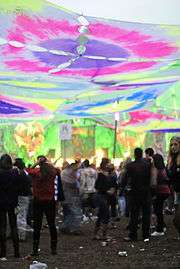
In the mid to late 1980s, a wave of psychedelic and other electronic dance music, most notably acid house music, emerged from acid house music parties in the mid-to-late 1980s in the Chicago area in the United States.[17] After Chicago acid house artists began experiencing overseas success, acid house quickly spread and caught on in the United Kingdom [18][19] within clubs, warehouses and free-parties, first in Manchester in the mid-1980s and then later in London. In the late 1980s, the word "rave" was adopted to describe the subculture that grew out of the acid house movement.[20] Activities were related to the party atmosphere of Ibiza, a Mediterranean island in Spain, frequented by British, Italian, Greek, Irish and German youth on vacation, who would hold raves and dance parties.[21]
Growth of the scene (1990s–present)
By the 1990s, genres such as acid, breakbeat hardcore, hardcore, happy hardcore, gabber, post-industrial and electronica were all being featured at raves, both large and small. There were mainstream events which attracted thousands of people (up to 25,000 instead of the 4,000 that came to earlier warehouse parties). Acid house music parties were first re-branded "rave parties" in the media, during the summer of 1989 by Genesis P-Orridge (Neil Andrew Megson) during a television interview; however, the ambience of the rave was not fully formed until the early 1990s. In 1990, raves were held "underground" in several cities, such as Berlin, Milan and Patras, in basements, warehouses and forests.[22]
British politicians responded with hostility to the emerging rave party trend. Politicians spoke out against raves and began to fine promoters who held unauthorized parties. Police crackdowns on these often unauthorized parties drove the rave scene into the countryside. The word "rave" somehow caught on in the UK to describe common semi-spontaneous weekend parties occurring at various locations linked by the brand new M25 London orbital motorway that ringed London and the Home Counties. (It was this that gave the band Orbital their name.) These ranged from former warehouses and industrial sites in London, to fields and country clubs in the countryside.
Characteristics
Location
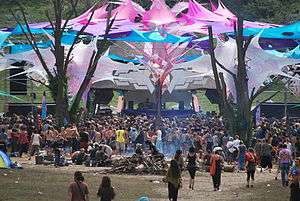
Prior to the commercialization of the rave scene, when large legal venues became the norm for these events, the location of the rave was kept secret until the night of the event, usually being communicated through answering machine messages,[23] mobile messaging, secret flyers, and websites. This level of secrecy, necessary for avoiding any interference by the police, on account of the illicit drug use, enabled the ravers to use locations they could stay in for ten hours at a time. It promoted the sense of deviance and removal from social control.[24] In the 2000s, this level of secrecy still exists in the underground rave scene. However "after-hours" clubs, as well as large outdoor events, create a similar type of alternate atmosphere, but focus much more on vibrant visual effects, such as props and décor. In more recent years, large commercial events are held at the same locations year after year with similar reoccurring themes every year. Events like Electric Daisy Carnival and Tomorrowland are typically held at the same venue that holds mass numbers of people.
Some raves make use of pagan symbolism. Modern raving venues attempt to immerse the raver in a fantasy-like world. Indigenous imagery and spirituality can be characteristic in the Raving ethos. In both the New Moon and Gateway collectives, "pagan altars are set up, sacred images from primitive cultures decorate the walls, and rituals of cleansing are performed over the turntables and the dance floor"[25] This type of spatial strategy is an integral part of the raving experience because it sets the initial "vibe" in which the ravers will immerse themselves. This said "vibe" is a concept in the raver ethos that represents the allure and receptiveness of an environment's portrayed and or innate energy. The landscape is an integral feature in the composition of rave, much like it is in pagan rituals. For example, The Numic Ghost Dancers rituals were held on specific geographical sites, considered to hold powerful natural flows of energy. These sites were later represented in the rhythmic dances, in order to achieve a greater level of connectivity.[26]
Notable venues
The following is an incomplete list of venues associated with the rave subculture:
- Asia
Europe
- Belgium
- Croatia
- England
- Angels (1992–96)
- Cream (1992–2015)
- Epping Forest Country Club
- Fabric(1999–present)
- Camden Palace (1982–2004)
- Gatecrasher One (1996–2007)
- Godskitchen (1996)
- Heaven (1979–present)
- Home (1998–2001)
- Koko (2004–present)
- Lakota (1990–present)
- Ministry of Sound (1991–present)
- Matter
- Megatripolis (1993–96)
- Popscene
- Quadrant Park (1988–91)
- Renaissance (1992)
- Sanctuary Music Arena
- Sankeys (1994–present)
- Shelley's Laserdome (1989–1995)
- The End (1995–2009)
- The Fridge (1981–2010)
- The Haçienda (1982–1997)
- Trade (1990–2008)
- Turnmills (1990–2008)
- France
- Germany
- Berghain (2004–present)
- Bunker (1992–1996)
- Dorian Gray (1978–2000)
- E-Werk (1993–1997)
- KitKatClub (1994–present)
- KW – Das Heizkraftwerk (1996–2003)
- Natraj Temple (1996–2008)
- Omen (1988–1998)
- Palazzo (1989–2003)
- Stammheim (1994–2002)
- Tresor (1991–present)
- U60311 (1998–2012)
- Ufo (1988–1990)
- Ultraschall (1994–2003)
- Ireland
- Romania
- Scotland
- The Arches (1991–2015)
- Hangar 13 (1993–95) [27]
- Sub Club (1987–present)
- Serbia
- Slovakia
- Spain
- Amnesia (1976–present)
- Cream Ibiza
- DC10
- Pacha Group (1967–present)
- Privilege Ibiza (1978–present)
- Sankeys
- Space Ibiza (1986–2016)
- Sweden
- Docklands (1995-2002)
Middle East
- Egypt
- Israel
- Lebanon
North America
- Canada
- Stereo nightclub
- The Guvernment (1996–2015);Mexico
- Magic Circus
- United States
- Aahz / Beacham Theater (1988–94)
- Catacombs Nightclub Philadelphia
- Club Glow
- Club Space
- Club Zanzibar (1979-1993)
- Masterdome
- Paradise Garage (1977–1987)
- Studio 54 (1977–1986)
- The Saint (1980–1988)
- Tunnel (1986–2001)
- U Street Music Hall
- Warehouse (1977–1987)
- speedway (las vegas) (2000-present)
Oceania
- Australia
- New Zealand
Dancing
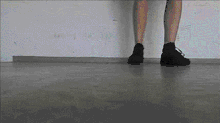
A sense of participation in a group event is among the chief appeals of rave music and dancing to pulsating beats is its immediate outlet.[28][29] Raving in itself is a syllabus-free dance, whereby the movements are not predefined and the dance is performed randomly, dancers take immediate inspiration from the music, their mood and watching other people dancing. Thus, the electronic, rave and club dances refer to the street dance styles that evolved alongside electronic music culture. Such dances are street dances since they evolved alongside the underground rave and club movements, without the intervention of dance studios. These dances were originated in some 'scenes' around the world, becoming known only to ravers or clubgoers who attempt to these locations. They were originated at some point that certain moves had begun to be performed to several people at those places, creating a completely freestyle, yet still highly complex set of moves, adaptable to every dancer change and dance whatever they want based on these moves. Many rave dancing techniques suggest using your body as an extension of the music, to loosen up, and let the music flow through the body to create a unique form of movement.
A common feature shared by all these dances, alongside with being originated at clubs, raves and music festivals around the world and in different years, is that when YouTube and other social media started to become popular (around 2006), these dances began to be popularized by videos of raves performing them, recording and uploading their videos. Therefore, they began to be practiced outside their places of origin, creating different 'scenes' in several countries. Furthermore, some of these dances began to evolve, and these dance 'scenes' are not totally related to the club/rave scenes they were originated. Also, the way of teaching and learning them have changed. In the past, if someone wanted to learn one of these dances, the person had to go to a club/rave, watch people dancing and try to copy them. Now, with social media, these dances are mostly taught on video tutorials and the culture spreads and grows inside those social media, like Flogger on Fotolog, Rebolation, Sensualize and Free Step on Orkut and Cutting Shapes on Instagram.[30]
Due the lack of studies dedicated to those dances, combined with poor and inaccurate information of them available on the Internet, it is hard to find reliable information.
Attire
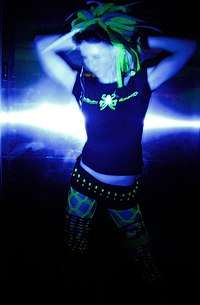

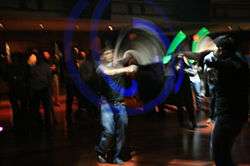
The loose, casual and sports clothing was originally adopted by the acid house set earlier on in Ibiza, utilizing easy-to-dance-in attire from hip hop and football/soccer culture. As well as clothing there developed a range of accessories carried by many ravers including: Vicks VapoRub, which ravers find pleasant under the influence of MDMA, pacifiers to satiate the need to grind one's teeth (bruxism) caused by taking MDMA, and glow sticks which adjunct the mild psychedelia of MDMA's effect.
In the United States and other countries, rave fashion is characterized by colorful clothing and accessories, most notably "kandi" jewellery, that fluoresce under ultraviolet light. They contain words or phrases that are unique to the raver and they can choose to trade with each other using "PLUR" (Peace, Love, Unity, Respect). In European countries, this kandi culture is much less common. Most raves are illegal and take place outside or in poorly heated warehouses, so keeping warm is a priority. Dreadlocks, dyed hair and mohawks are popular, as are tattoos and piercings. Clothing is vibrant and alternative, often taking inspiration from new-age punk and grunge style. However, there is no set dress code for the illegal rave scene. Some global rave events such as Sensation adopted a strict minimalistic dress policy, either all white or black attire.
Since rave culture has seen such an explosion in the US since 2010 as the rave scene is no longer illegal or underground, raves in the US are now so popular that there are many brands, retailers, and websites selling apparel, costumes, and accessories just for those who go to dress up at raves. This style of attire, along with the entire rave culture, is now spilling out into the mainstream, especially in the US. Sometimes called "rave fashion" or "festival fashion," it now includes all kinds of accessories to create unique looks depending on the person and event.[31]
Light shows
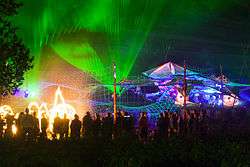
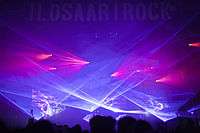
Some ravers participate in one of four light-oriented dances, called glowsticking, glowstringing, gloving, and lightshows. Of the four types of light-orientated dances, gloving in particular has evolved beyond and outside of the rave culture. Other types of light-related dancing include LED lights, flash-lights and blinking strobe lights. LEDs come in various colours with different settings. Gloving has evolved into a separate dance form that has grown exponentially in the last couple of years. Since then the culture has extended to all ages, ranging from kids in their early teens to college students and more. The traditional Rav'n lights are limited now, but many stores have developed newer, brighter, and more advanced version of lights with a plethora of colors and modes—modes include solid, stribbon, strobe, dops, hyper flash, and other variations.
Drug use

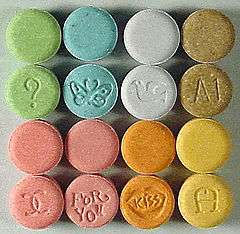

Among the various elements of 1970s disco subculture that ravers drew on, in addition to basing their scene around dance music mixed by DJs, ravers also inherited the positive attitude towards using club drugs to "enhanc[e]...the sensory experience" of dancing to loud music.[32] However, disco dancers and ravers preferred different drugs. Whereas 1970s disco scene members preferred cocaine and the depressant/sedative Quaaludes, ravers preferred MDMA, 2C-B, amphetamine, morphine and other pills. According to the FBI, raves are one of the most popular venues where club drugs are distributed, and as such feature a prominent drug subculture.[33][34] Club drugs include MDMA (more commonly known as "ecstasy", "E" or "molly"), 2C-B (more commonly known as "nexus"), amphetamine (commonly referred to as "speed"), morphine (commonly known as "morphy" or "M" ), GHB (commonly referred to as "fantasy" or "liquid E"), cocaine (common short name for "coke"), DMT and LSD (commonly referred to as "lucy" or "acid").
"Poppers" is the street name for alkyl nitrites (the most well-known being amyl nitrite), which are inhaled for their intoxicating effects, notably the "rush" or "high" they can provide. Nitrites originally came as small glass capsules that were popped open, which led to the nickname "poppers." The drug became popular in the US first on the disco/club scene of the 1970s and then at dance and rave venues in the 1980s and 1990s. In the 2000s, synthetic phenethylamines such as 2C-I, 2C-B and DOB have been referred to as club drugs due to their stimulating and psychedelic nature (and their chemical relationship with MDMA).[35] By late 2012, derivates of the psychedelic 2C-X drugs, the NBOMes and especially 25I-NBOMe, had become common at raves in Europe. In the U.S., some law enforcement agencies have branded the subculture as a drug-centric culture, as rave attendees have been known to use drugs such as cannabis, 2CB, and DMT.
Groups that have addressed alleged drug use at raves e.g. the Electronic Music Defense and Education Fund (EM:DEF), The Toronto Raver Info Project (Canada), DanceSafe (USA and Canada), and Eve & Rave (Germany and Switzerland), all of which advocate harm reduction approaches. In 2005, Antonio Maria Costa, Executive Director of the United Nations Office on Drugs and Crime, advocated drug testing on highways as a countermeasure against drug use at raves. Much of the controversy, moral panic and law enforcement attention directed at rave culture and its association with drug use may be due to reports of drug overdoses (particularly MDMA) at raves, concerts and festivals.[36]
History by country
Canada
In 2001 Calgary, Alberta became the first major municipality in Canada to pass a bylaw with respect to raves. The intent of the bylaw was to ensure that raves would be safe for participants, and also not unduly disruptive to adjacent neighbourhoods. The bylaw was created in consultation with representatives from the municipality, the province of Alberta, and the rave community.[37]
Germany
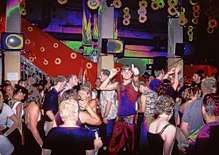
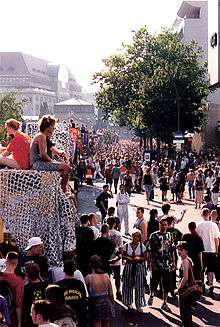
By 1988, acid house was making as significant an impact on popular consciousness in Germany and Central Europe as it had in England.[38] In 1989 German DJs Westbam and Dr. Motte established the Ufo Club, an illegal party venue, and co-founded the Love Parade.[39][40] On 9 November 1989 the Berlin Wall fell, free underground Techno parties mushroomed in East Berlin, and a rave scene comparable to that in the UK was established.[39] East German DJ Paul van Dyk has remarked that the Techno-based rave scene was a major force in re-establishing social connections between East and West Germany during the unification period.[41] In urbanized Germany raves and techno parties often preferred industrial sceneries such as decommissioned power stations, factories, the canalization or former military properties of the cold war.[42]
In 1991 a number of party venues closed, including Ufo, and the Berlin Techno scene centred itself around three locations close to the foundations of the Berlin Wall: the E-Werk, the Bunker and the now legendary Tresor.[43] In the same period, German DJs began intensifying the speed and abrasiveness of the sound, as an acid-infused techno began transmuting into hardcore.[44] This emerging sound was influenced by Dutch gabber and Belgian hardcore. Other influences on the development of this style were European Electronic Body Music groups of the mid-1980s such as DAF, Front 242, and Nitzer Ebb.[45]
Across Europe, rave culture was becoming part of a new youth movement. DJs and electronic-music producers such as Westbam proclaimed the existence of a "raving society" and promoted electronic music as legitimate competition for rock and roll. Indeed, electronic dance music and rave subculture became mass movements. Since the mid 1990s, raves had tens of thousands of attendees, youth magazines featured styling tips, and television networks launched music magazines on House and Techno music.[46][47] The annual Love Parade festivals in Berlin and later the Metropolitan Ruhr area repeatedly attracted more than one million party-goers between 1997 and 2010. Dozens of other annual technoparades took place in Germany and Central Europe at that time, the largest ones being Union Move, Generation Move, Reincarnation and Vision Parade as well as Street Parade and Lake Parade in Switzerland. Large commercial raves since the nineties include Mayday, Nature One, Time Warp, SonneMondSterne and Melt!. Beyond Berlin, further centers of the techno and rave scene of the 1990s and 2000s in Germany were Frankfurt (famous clubs were Omen, Dorian Gray, Cocoon and U60311) and Munich (Ultraschall, KW – Das Heizkraftwerk, Natraj Temple, Harry Klein and Rote Sonne).[48][47]
Further popular venues include Stammheim (Aufschwung Ost) in Kassel, Tunnel Club in Hamburg and Distillery in Leipzig. Since the late 2000s, Berlin is still called the capital of electro music and rave, and techno clubs such as Berghain, Tresor, Watergate or KitKatClub and the way to party in barely renovated venues, ruins or wooden shacks such as, among many others, Club der Visionaere, Wilde Renate, Fiese Remise or Bar 25, attracted international media attention.[49] One movie that portraits this scene of the 2000s is Berlin Calling starring Paul Kalkbrenner. In the 2010s, there remains a vivid rave and techno scene throughout the country, including numerous festivals and world-class techno clubs also outside of Berlin, such as for example MMA Club (Mixed Munich Arts) in Munich, Institut für Zukunft in Leipzig or Robert Johnson in Offenbach.[50]
United Kingdom
Birth of UK rave scene (1980s–1990s)
The UK was finally recognized for its rave culture in the late 1980s and early 1990s. By 1991, organisations such as Fantazia and Raindance were holding massive legal raves in fields and warehouses around the country. The Fantazia party at Castle Donington, July 1992 was an open-air, all-night event. The Vision at Pophams airfield in August 1992 and Universe's Tribal Gathering in 1993 had a more festival feel.
By the middle of 1992, the scene was slowly changing, with local councils passing by-laws and increasing fees in an effort to prevent or discourage rave organisations from acquiring necessary licences. This meant that the days of the large one-off parties were numbered. By the mid-1990s, the scene had also fragmented into many different styles of dance music, making large parties more expensive to set up and more difficult to promote. The sound driving the big raves of the early 1990s had by the end of 1993 split into two distinct and polarising styles, the darker jungle and the faster happy hardcore. Although many ravers left the scene due to the split, promoters such as ESP Dreamscape and Helter Skelter still enjoyed widespread popularity and capacity attendances with multi-arena events catering to the various genres. Notable events of this period included ESP's outdoor Dreamscape 20 event on 9 September 1995 at Brafield aerodrome fields, Northants and Helter Skelter's Energy 97 outdoor event on 9th Aug 1997 at Turweston Aerodrome, Northants.
Free parties and outlawing of raves (1992–1994)
The illegal free party scene also reached its zenith for that time after a particularly large festival, when many individual sound systems such as Bedlam, Circus Warp, DIY, and Spiral Tribe set up near Castlemorton Common. The government acted. Under the Criminal Justice and Public Order Act 1994, the definition of music played at a rave was given as:
"Music" includes sounds wholly or predominantly characterised by the emission of a succession of repetitive beats.
— Criminal Justice and Public Order Act 1994[51]
Sections 63, 64 & 65 of the Act targeted electronic dance music played at raves. The Criminal Justice and Public Order Act empowered police to stop a rave in the open air when a hundred or more people are attending, or where two or more are making preparations for a rave. Section 65 allows any uniformed constable who believes a person is on their way to a rave within a five-mile radius to stop them and direct them away from the area; non-compliant citizens may be subject to a maximum fine not exceeding level 3 on the standard scale (£1000). The Act was officially introduced because of the noise and disruption caused by all night parties to nearby residents, and to protect the countryside. However, some participants in the scene claimed it was an attempt to lure youth culture away from MDMA and back to taxable alcohol.[52] In November 1994, the Zippies staged an act of electronic civil disobedience to protest against the CJB (i.e., Criminal Justice Bill).
Legal and underground raves (1994–present)
After 1993, the main outlet for raves in the UK were a number of licensed parties, amongst them Helter Skelter, Life at Bowlers (Trafford Park, Manchester), The Edge (formerly the Eclipse [Coventry]), The Sanctuary (Milton Keynes) and Club Kinetic.[53] In London, itself, there were a few large clubs that staged raves on a regular basis, most notably "The Laser Dome", "The Fridge", "The Hippodrome", "Club U.K.", and "Trade." "The Laser Dome" featured two separate dance areas, "Hardcore" and "Garage", as well as over 20 video game machines, a silent-movie screening lounge, replicas of the "Statue of Liberty", "San Francisco Bridge", and a large glass maze. In Scotland, event promoters Rezerection held large-scale events across the country.
By 1997, the popularity of weekly Superclub nights had taken over from the old Rave format, with a raft of new club-based genres sweeping in (e.g. Trance, Hard House, Speed and UK garage) alongside the more traditional House sound that had regained popularity. Clubs like Gatecrasher and Cream rose to prominence with dress codes and door policies that were the polar opposite of their rave counterparts; stories of refused entry due to not wearing the right clothing were commonplace, but seemingly did nothing to deter Superclub attendance.
United States
Origins in disco and psychedelia (1970s)
American ravers, following their early UK & European counterparts, have been compared to the hippies of the 1960s due to their shared interest in non-violence and psychedelia.[54] Rave culture incorporated disco culture's same love of dance music spun by DJs, drug exploration, sexual promiscuity, and hedonism. Although disco culture had thrived in the mainstream, the rave culture would make an effort to stay underground to avoid the animosity that was still surrounding disco and dance music. The key motive for remaining underground in many parts of the US had to do with curfew and the standard 2:00 am closing of clubs. It was a desire to keep the party going past legal hours that created the underground direction. Because of the legality, they had to be secretive about time and place.
New York raves and party promoters (1980s)
In the late 1980s, rave culture began to filter through into North America from English expatriates and from US DJs who would visit Europe. However, rave culture's major expansion in North America is often credited to Frankie Bones, who after spinning a party in an aircraft hangar in England, helped organize some of the earliest American raves in the 1990s in New York City called "Storm Raves". Storm Raves had a consistent core audience, fostered by zines by fellow Storm DJ (and co-founder, with Adam X and Frankie Bones, of the US techno record store, Groove Records.). Heather Heart held Under One Sky. Simultaneously in NYC, events were introducing electronic dance music to this city's dance scene. Between 1992 and 1994, promotional groups sprung up across the east coast.
San Diego and Latin America (1990s)
In the 1990s, San Diego held large raves with audiences of thousands. These festivals were held on Indian reservations and ski resorts during the summer months and were headlined by DJs such as Doc Martin, Dimitri of Deee-lite, Afrika Islam and the Hardkiss brothers from San Francisco. They helped to create the Right to Dance movement—a non violent protest held in San Diego and later in Los Angeles.
Featuring local San Diego DJs Jon Bishop, Steve Pagan, Alien Tom, Jeff Skot and Mark E. Quark performed at these events. The events used large props and themes. The fairy and pixie craze, with ravers getting fairy tattoos and wearing fairy wings to parties was associated with the region. The percussive group Crash Worship was active here.
Growth in California
In the late 1980s and early 1990s, there was a boom in rave culture in the San Francisco Bay Area. At first, small underground parties sprung up all over the SOMA district in vacant warehouses, loft spaces, and clubs. The no alcohol rule fueled the ecstasy-driven parties. Small underground raves were just starting out and expanding beyond SF to include the East Bay, the South Bay area including San Jose, Santa Clara, and Santa Cruz beaches.
In late 1991, raves started to expand across northern California, and cities like Sacramento, Oakland, Silicon Valley (Palo Alto, San Jose). The massive parties were taking place in outdoor fields, airplane hangars and hilltops that surround the valley. San Francisco's early promoters and DJs were from the UK and Europe. Raves took place the SOMA art museum, 'Where the wild things are' museum on top of the Sony Metreon, and in the Maritime hall (1998–2002).
By the end of 1994, a new generation of ravers were attracted by the new sounds. EDM began to become popular. Raves could be found in many different kinds of venues, as opposed to just basements and warehouses. Promoters started to take notice and put together the massives of the late 1990s with many music forms under one roof for 12-hour events. 2000 saw the demise of massive raves as curfews were placed on permits handed out to promoters. Instead of all night and into the next day, parties now had to end at 2 a.m. Smaller, intimate venues continued just like they had from the start and underground raves became the norm. The death of an attendee who had taken MDMA at the Electric Daisy Carnival in 2010 put a negative spin on raves in LA and California.
Seattle
Through the mid 1990s and into the 2000s the city of Seattle also shared in the tradition of West Coast rave culture. Though a smaller scene compared to San Francisco, Seattle also had many different rave crews, promoters, Djs, and fans. Candy Raver style, friendship and culture became popular in the West Coast rave scene, both in Seattle and San Francisco. At the peak of West Coast rave, Candy Raver, and massive rave popularity (1996–1999,) it was common to meet groups of ravers, promoters, and Djs who frequently travelled between Seattle and San Francisco, which spread the overall sense of West Coast rave culture and the phenomenon of West Coast "massives".
Recent years (2000s)
By 2010, raves were becoming the equivalent of large-scale rock music festivals, but many times even bigger and more profitable. The Electric Daisy Carnival in Las Vegas drew more than 300,000 fans over three days in the summer of 2012, making it the largest EDM music festival in North America. Ultra Music Festival in Miami drew 150,000 fans over three days in 2012 while other raves like Electric Zoo in New York, Beyond Wonderland in LA, Movement in Detroit, Electric Forest in Michigan, Spring Awakening in Chicago, and dozens more now attract hundreds of thousands of "ravers" every year. These new EDM-based rave events (now simply referred generically to as "music festivals") sell out. Festival attendance at the Electric Daisy Carnival (EDC) increased by 39.1%, or 90,000 attendees from 2011 to 2012. In 2013, EDC had attendance of approximately 345,000 people, a record for the festival. The average ticket for EDC cost over $300 and the event contributed $278 million to the Clark County economy in 2013.[55] This festival takes place at a 1,000-acre complex featuring a half dozen custom built stages, enormous interactive art installations, and hundreds of EDM artists. Insomniac, a US EDM event promoter, holds yearly EDC and other EDM events.
Australia
1980s and 1990s: outdoor raves and the Sydney scene
Rave parties began in Australia as early as the 1980s and continued well into the late 1990s. They were mobilised versions of the 'warehouse parties', across Britain. Similar to the United States and Britain, raves in Australia were unlicensed and held in spaces normally used for industrial and manufacturing purposes, such as warehouses, factories and carpet showrooms. In addition, suburban locations were also used: basketball gymnasiums, train stations and even circus tents were all common venues. In Sydney, common areas used for outdoor events included Sydney Park, a reclaimed garbage dump in the inner south west of the city, Cataract Park and various other natural, unused locations and bush lands. The raves placed a heavy emphasis on the connection between humans and the natural environment, thus many raves in Sydney were held outdoors, notably the 'Happy Valley' parties (1991–1994), 'Ecology' (1992) and 'Field of Dreams 4' (July 6, 1996).[56][57] The mid-late 1990s saw a slight decline in rave attendance, attributed to the death of Anna Wood at a licensed inner-city Sydney venue, which was hosting a rave party known as "Apache". Wood had taken ecstasy and died in hospital a few days later, leading to extensive media exposure on the correlation of drug culture and its links to the rave scene in Australia.
2000s–present
The tradition continued in Melbourne, with 'Earthcore' parties. Raves also became less underground as they were in the 1990s, and many were held at licensed venues well into the 2000s. Despite this, rave parties of 1990s size became less common. Nonetheless, the rave scene in Australia experienced a resurgence after 2010. During this period the resurfacing of the "Melbourne Shuffle", a Melbourne club/rave dance style, became a YouTube trend and videos were uploaded. The rave subculture in Melbourne was strengthened with the opening of clubs such as Bass Station and Hard Candy and the rise of free party groups such as Melbourne Underground. Melbourne helped keep raving culture alive with young people.
Notable events
The following is an incomplete list of notable raves, particularly smaller raves that may not fit the profile of being an electronic dance music festival:
|
|
Notable soundsystems
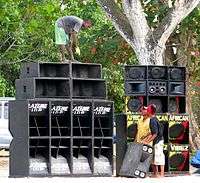
The following is an incomplete list of notable sound systems:
See also
- Acid house party – Forerunner of raves typically originating from Chicago, Illinois.
- Algorave
- ArtRave: The Artpop Ball
- Music festival
- New Rave
- Nightclub
- Outline of entertainment
- RAVE Act – An American law targeting raves.
- Rave Board Game – 1991 board game based on the UK Rave scene
- Responsible drug use § On festivals
- Zippies
References
- 1 2 3 4 https://www.theguardian.com/music/2012/aug/02/how-rave-music-conquered-america
- ↑ http://www.dailymail.co.uk/news/article-2273707/Mother-41-takes-month-old-baby-drum-bass-rave-Wales.html
- ↑ http://www.dummymag.com/lists/the-10-best-drum-and-bass-tracks-according-to-goldie
- 1 2 3 4 5 https://www.drugabuse.gov/drugs-abuse/club-drugs
- 1 2 3 4 5 6 https://www.ncbi.nlm.nih.gov/pmc/articles/PMC4458153/
- ↑ http://www.thejournal.ie/scott-weiland-drugs-death-2511702-Dec2015/
- ↑ https://qz.com/681175/ketamine-better-known-as-the-rave-drug-special-k-could-be-our-next-anti-depressant/
- ↑ http://www.ministryofcannabisblog.com/2018/02/06/marijuana-in-the-rave-culture-of-the-90s/
- ↑ http://www.propertyguardianprotection.com/blog/rave-squat-party-revival
- ↑ https://www.theguardian.com/music/2014/apr/16/illegal-raves-return-with-social-media-messages
- ↑ https://www.bbc.co.uk/bbcthree/article/66df895b-af1c-416f-b32a-bb3576dbcb82
- ↑ https://www.independent.co.uk/arts-entertainment/the-ravers-return-how-underground-parties-are-making-a-comeback-a7036131.html
- 1 2 Helen Evans. "OUT OF SIGHT, OUT OF MIND: An Analysis of Rave culture". Retrieved 25 October 2007.
The term rave first came into use in late 50s Britain as a name for the wild bohemian parties of the time.
- ↑ Fordham, John (2007-01-04). "Obituary: Mick Mulligan". The Guardian. ISSN 0261-3077. Retrieved 2017-11-27.
- ↑ Thinkmap, Inc. "Buddy Holly, Wordsmith". visualthesaurus.com.
- ↑ "Unit Delta Plus". Delia Derbyshire. Retrieved 25 October 2007.
Perhaps the most famous event that Unit Delta Plus participated in was the 1967 Million Volt Light and Sound Rave at London's Roundhouse, organised by designers Binder, Edwards and Vaughan (who had previously been hired by Paul McCartney to decorate a piano). The event took place over two nights (28 January and 4 February 1967) and included a performance of tape music by Unit Delta Plus, as well as a playback of the legendary Carnival of Light, a fourteen-minute sound collage assembled by McCartney around the time of the Beatles' Penny Lane sessions.
- ↑ Phil Cheeseman-fu. "The History Of House". DJ Magazine. Retrieved August 13, 2013.
- ↑ "Acid House Music – The Timeline (The History of House – "Garage, Techno, Jungle. It's all House")". Fantazia.org. Retrieved August 13, 2013.
- ↑ Altered State – The Story of Ecstasy Culture and Acid House, Matthew Collin (contributions by John Godfrey), Serpent's Tail, 1997 ( ISBN 1852423773)
- ↑ Simon Parkin (May 1999). "Visual Energy".
- ↑ "The Problem of Rave Parties", Michael S. Scott, Center for Problem Oriented Policing, 2009, webpage: popc-rave.
- ↑ Timeline and numbers Reynolds, Simon (1998). Generation Ecstasy: into the world of Techno and Rave culture. Picador. ISBN 0-330-35056-0.
- ↑ Chester, Jerry (2017-05-28). "The rave that changed the law". BBC News. Retrieved 2017-11-27.
- ↑ Tammy L. Anderson, "Understanding the Alteration and Decline of a Music Scene: Observations from Rave Culture". Sociological Forum, vol.24 no.2 (2009) 309–311. Accessed 10/02/2013 16:19, Stable URL: https://www.jstor.org/stable/40210403 .
- ↑ Hutson, Scott R. (2000). "The Rave: Spiritual Healing in Modern Western Subcultures". Anthropological Quarterly. 73 (1): 40–41. JSTOR 3317473.
- ↑ Carroll, Alex K.; Zedeno, M. Nieves; Stoffle, Richard W. (2004). "Landscape of the Ghost Dance: A Cartography of Numic Ritual". Journal of Archeological Method and Theory. 11 (2): 141–143. doi:10.1023/b:jarm.0000038064.42041.aa. JSTOR 20164812.
- ↑ Arlidge, John. "The day the music died, Hanger 13, Scotland's top rave venue, has been closed after three Ecstasy-related deaths". https://www.independent.co.uk/. The Independent Newspaper UK. Retrieved 5 October 2015. External link in
|website=(help) - ↑ Everit, Anthony. Joining In: An investigation in participatory music (PDF). Archived from the original (PDF) on 31 July 2013.
A rave or a rock concert is not simply a presentation which audiences attend, but a communal event (like a secular church service) in which everyone has an active part.
- ↑ Turino, Thomas. Music as Social Life: The Politics of Participation. Chicago: University of Chicago Press.
- ↑ Heller, David. "I-Rave: digiphrenia's transformation of a culture" (PDF). University of Hawai'i at Mãnoa. Retrieved November 6, 2016.
- ↑ Mary Grace Cerni. "The Evolution of Rave Fashion". L.A. Weekly.
- ↑ Gahlinger, Paul M. (1 June 2004). "Club Drugs: MDMA, Gamma-Hydroxybutyrate (GHB), Rohypnol, and Ketamine". American Family Physician. 69 (11).
- ↑ "Archived copy". Archived from the original on 29 March 2016. Retrieved 27 April 2016.
- ↑ Adlaf, Edward M.; Smart, Reginald G. (1997). "Party Subculture or Dens of Doom? An Epidemiological Study of Rave Attendance and Drug Use Patterns Among Adolescent Students". Journal of Psychoactive Drugs. 29 (2): 193–198. CiteSeerX 10.1.1.563.3586. doi:10.1080/02791072.1997.10400187. ISSN 0279-1072. PMID 9250946.
- ↑
- ↑ Armenian, Mamantov, Tsutaoka, Gerona, Silman, Wu, Olson (2012). "Multiple MDMA (Ecstasy) Overdoses at a Rave Event-A Case Series". Journal of Intensive Care Medicine. 28 (4): 252–258. CiteSeerX 10.1.1.668.2071. doi:10.1177/0885066612445982. PMID 22640978.
- ↑ Hunter, Sylvia (2002). "Raves reviewed: An extended dance event bylaw". Plan Canada. 42 (1): 27–28. doi:10.25316/ir-158. ISSN 0032-0544 – via VIUSpace.
- ↑ Short excerpt from special on German "Tele 5" from Dec.8, 1988. The show is called "Tanzhouse" hosted by a young Fred Kogel. It includes footage from Hamburg's "Front" with Boris Dlugosch, Kemal Kurum's "Opera House" and the "Prinzenbar".
- 1 2 Robb, D. (2002), Techno in Germany: Its Musical Origins and Cultural Relevance, German as a Foreign Language Journal, No.2, 2002, (p. 134).
- ↑ "The pioneering days of techno" (in German). Der Spiegel. 31 July 2008. Retrieved 25 February 2017.
- ↑ Messmer, S. (1998), Eierkuchensozialismus, TAZ, 10.7.1998, (p. 26).
- ↑ "Youth: Love and Cabbage" (in German). Der Spiegel. 26 August 1996. Retrieved 25 February 2017.
- ↑ Henkel, O.; Wolff, K. (1996) Berlin Underground: Techno und Hiphop; Zwischen Mythos und Ausverkauf, Berlin: FAB Verlag, (pp. 81–83).
- ↑ Schuler, M. (1995), "Gabber + Hardcore" (p. 123), in Anz, P.; Walder, P. (eds.) (1999 rev. edn, 1st publ. 1995, Zurich: Verlag Ricco Bilger) Techno. Reinbek: Rowohlt Taschenbuch Verlag.
- ↑ Reynolds, S. (1998), Energy Flash: a Journey Through Rave Music and Dance Culture, Pan Macmillan, (p. 110).
- ↑ "Young is the Night: Nightlife from A to Z" (in German). Der Spiegel. 1 August 1998. Retrieved 25 February 2017.
- 1 2 "Corpus Techno: The music of the future will soon be history". MUNICHfound.com. July 1997. Retrieved 25 February 2017.
- ↑ Hitzler, Ronald; Pfadenhauer, Michaela; Hillebrandt, Frank; Kneer, Georg; Kraemer, Klaus (1998). "A posttraditional society: Integration and distinction within the techno scene". Loss of safety? Lifestyles between multi-optionality and scarcity (in German). p. 85. doi:10.1007/978-3-322-83316-7. ISBN 978-3-531-13228-0.
- ↑ "In Berlin, Still Partying in the Ruins". New York Times. 21 November 2014. Retrieved 25 February 2017.
- ↑ "The 10 best clubs in Germany that aren't in Berlin". Electronic Beats. 30 January 2017. Retrieved 31 August 2017.
- ↑ "Public Order: Collective Trespass or Nuisance on Land – Powers to remove trespassers on land – Powers to remove persons attending or preparing for a rave". Criminal Justice and Public Order Act 1994. Her Majesty's Stationery Office. 1994. Retrieved 9 June 2008.
- ↑ Simon Reynolds, Energy Flash: A Journey through Rave Music and Dance Culture, Pan Macmillan, (p. 149) ( ISBN 0330350560)
- ↑ "REZERECTION – THE OFFICIAL WEBSITE (z)". Archived from the original on 28 September 2007. Retrieved 25 October 2007.
- ↑ Energy Flash, Simon Reynolds, (p276 & 290), 1998, Macmillan Publishers ( ISBN 0330350560)
- ↑ "Archived copy". Archived from the original on 21 January 2015. Retrieved 21 January 2015.
- ↑ Pagan, Chris. "Rave culture in Sydney, Australia: mapping youth spaces in media discourse" (PDF). University of Sydney. Retrieved January 8, 2014.
- ↑ "Timeline of Sydney Raves from the website – Sydney Rave History".
- ↑ wender, Dan. "How Frankie Bones' Storm Rave Birthed the "PLUR" Movement". thump.vice.com. Thump/Vice Webzine, Paragraph 8, 13 May 2015. Retrieved 31 July 2016.
Further reading
- Collin, Matthew. Altered State: The Story of Ecstasy and Acid House. London: 1997 : Serpent's Tail – How rave dances began in Manchester, England in the Summer of 1988 (the Second Summer of Love) and the aftermath. ISBN 1-85242-604-7
- Reynolds, Simon. Generation Ecstasy: Into the world of Techno and Rave culture. New York: Little, Brown and Company, 1998. ISBN 0-316-74111-6
- Ott, Brian L. and Herman, Bill D. Excerpt from Mixed Messages: Resistance and Reappropriation in Rave Culture. 2003.
- Evans, Helen. Out of Sight, Out of Mind: An Analysis of Rave culture. Wimbledon School of Art, London. 1992. Includes bibliography through 1994.
- St John, Graham (ed). 2004. Rave Culture and Religion. New York: Routledge. ISBN 0-415-31449-6
- St John, Graham. 2009. Technomad: Global Raving Countercultures. London: Equinox. ISBN 978-1-84553-626-8.
- Griffin, Tom. Playgrounds: a portrait of rave culture. 2005. ISBN 0-646-45135-9. Official Website WALLAWALLA
- Kotarba, Joseph. 1993. The Rave Scene in Houston, Texas: An Ethnographic Analysis. Austin: Texas Commission on Alcohol and Drug Abuse.
- Thomas, Majeedah. Together: Friday Nights At The Roxy 2013. ISBN 978-1630005788. Official Website
External links
| Look up rave in Wiktionary, the free dictionary. |

- Regional community links at Curlie (based on DMOZ)